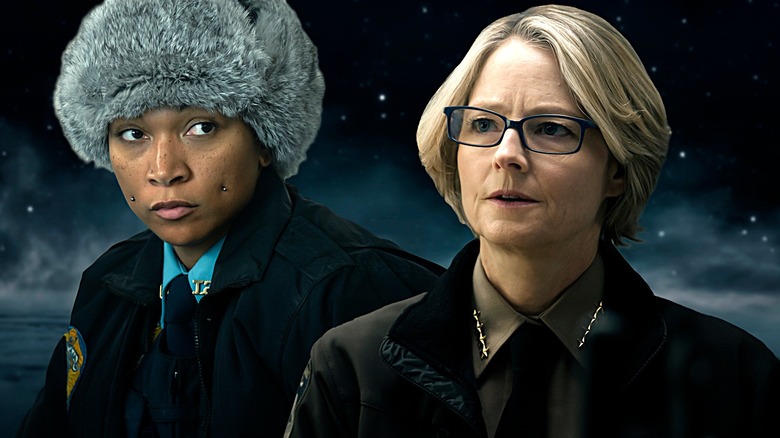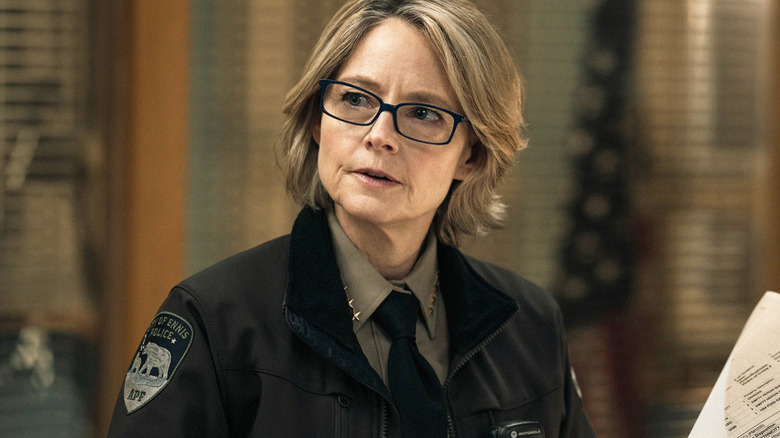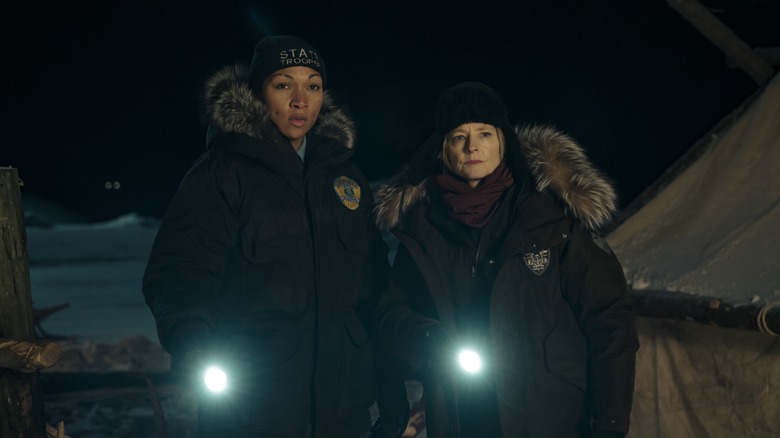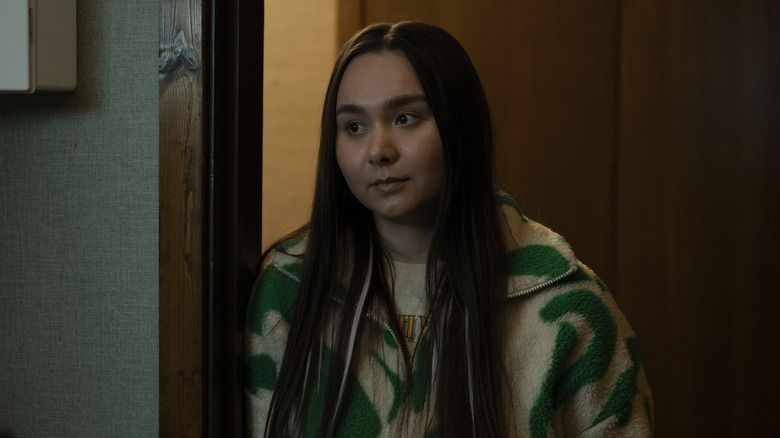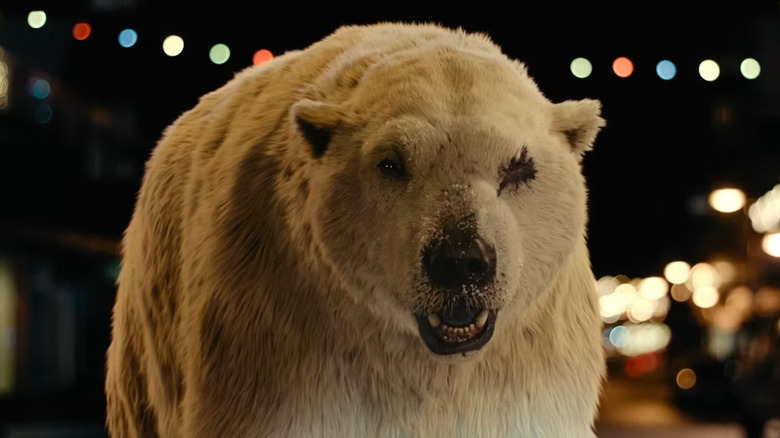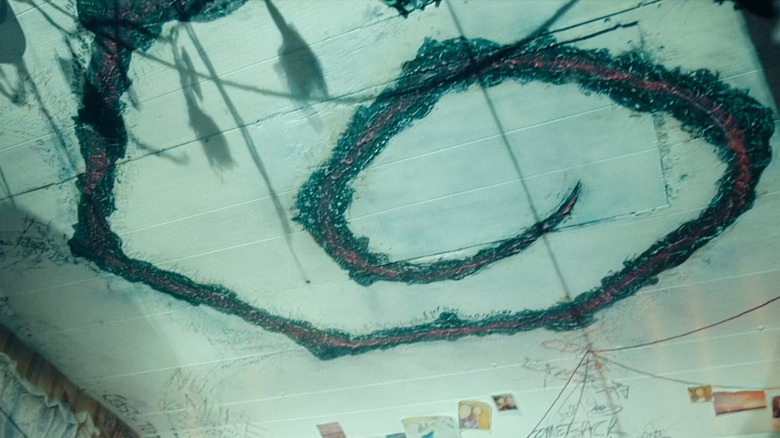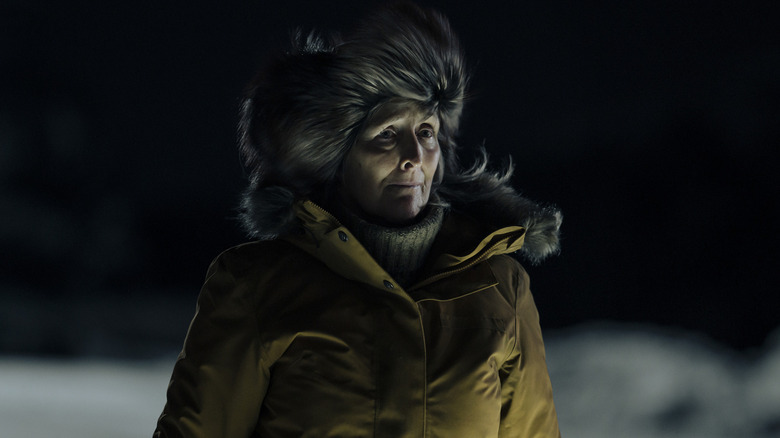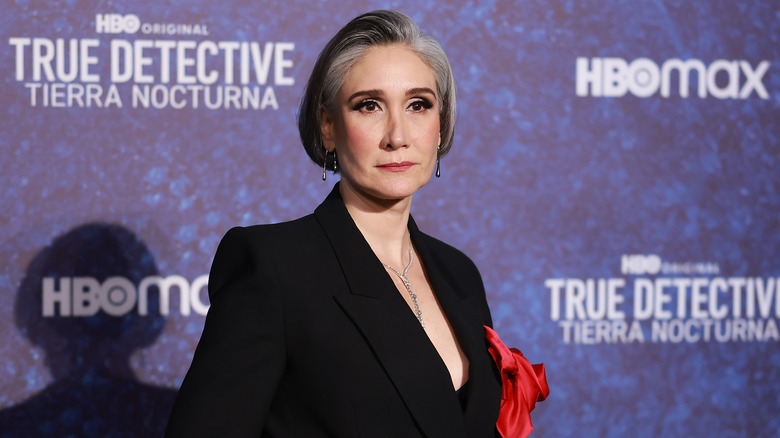The Ending Of True Detective: Night Country Explained
The following article includes references to suicide, mental illness, and domestic violence.
If you were hoping for everything to wrap up cleanly at the end of "True Detective: Night Country," the season finale may leave you a little disappointed. We get explanations for the Tsalal deaths and the murder of Annie Kowtok (Nivi Pedersen), but a lot of threads are left blowing in the Alaskan wind. Some characters leave relationships in a middle ground with no real resolution offered. And as for the show's extensive supernatural component, well, let's just say things are left open for interpretation.
That's not inherently a bad thing, of course. A mystery show has the right to leave some things mysterious, especially when ghosts and deadly forces of nature are commonplace. The fictional town of Ennis, Alaska remains the star of the season all the way through to the end, and it's in the gorgeous shots of harsh blizzards and the northern lights that "Night Country" finds some kind of ethereal closure. Lead protagonists Liz Danvers (Jodie Foster) and Evangeline Navarro (Kali Reis) get the meat of the material in the show's final episode, completing character arcs that, while emotionally powerful, leave a bit to be desired.
There are shocking twists, sad revelations, and even more suggestions of the supernatural before all is said and done. So, let's dig into the ending of "True Detective: Night Country," unpack what actually happens, and try to figure out what it all means.
What you need to remember about the plot of True Detective: Night Country
"True Detective: Night Country" follows two core investigations: the cold-case murder of Iñupiat activist Annie Kowtok and the mysterious deaths of the scientists at the Tsalal Research Station. It quickly becomes clear that the two cases are one and the same. Liz and Navarro discover that the same international owners fund both the research station and the local Silver Sky mine, which has been polluting the water supply and causing extensive health problems in the surrounding (primarily Indigenous) community. They believe that the research station has been publishing bogus pollution numbers to protect the mine's operations and that Annie was killed to silence her investigation into this corruption.
At the same time that this is all unraveling, we learn more and more about both main characters. Liz's tragic past is unveiled slowly — a drunk driving accident that took her husband and son from her, leaving her alone with her stepdaughter Leah (Isabella Star LaBlanc). On Navarro's side, we learn that her mother struggled with mental health issues and may have been haunted by supernatural phenomena. The same issues plague her sister Julia (Aka Niviâna), who kills herself halfway through the season.
Lastly, we learn about the case that drove a wedge between Liz and Navarro; how they killed a serial domestic abuser and made it look like a suicide. This secret is unearthed by Hank Prior (John Hawkes) when he breaks into his son's laptop to dig up dirt on Liz — something the mine has paid him to do.
What happens at the end of True Detective: Night Country?
The real kickoff to the final act of "True Detective: Night Country" comes at the end of Episode 5, when a tense standoff in Liz's house ends with Pete Prior (Finn Bennett) shooting his father in the head to protect Liz. It's a brutal, shocking scene, and one that the show leaves little time to reflect on. One might ask why Prior's first instinct is to go for an instant kill shot, but once Episode 6 begins, there's little room for that kind of explanation: Things keep moving at a breakneck pace.
Liz and Navarro access the secret ice caves where Annie was killed and discover that they connect to the Tsalal Research Station. They also find the science team's only survivor, Raymond Clark (Owen McDonnell), hiding there. Upon questioning, Clark reveals the truth. While he and Annie were dating, she discovered the connection between the station and the mine. She also learned that the scientists weren't just covering up pollution numbers but actually encouraging Silver Sky to pump out more pollutants. Doing so helped to soften the permafrost blocking them from their true focus — an ancient microorganism that could revolutionize medicine. The scientists caught and killed her, and Hank was paid to move her body.
What follows is a long night of strange happenings. The power goes out; Liz and Navarro both have strange visions; and Clark is released after filming a confession, going off to freeze to death in the snow voluntarily. The two detectives make it through the cold and are rewarded with both a sense of clarity and the beauty of the aurora borealis.
The truth behind the Tsalal murders
Clark's confession explains how Annie was killed, but it doesn't shed any light on the other scientists' mysterious deaths. That only starts to make sense at the very end of the episode when Liz and Navarro pay a visit to some of the local Iñupiat women who worked regularly as cleaning staff at the station. After Navarro tells them her Iñupiat name — something she learns in a vision during the blizzard — they willingly reveal that they killed the scientists as a group in an act of vengeance.
After discovering what happened to Annie, the Iñupiat women infiltrated the station using their intricate knowledge of it, forced the researchers into a truck, and released them naked onto the ice for Annie's spirit and the other supernatural forces around Ennis to pass judgment on. In a mirror of their old domestic violence-turned-murder case, Liz and Navarro turn a blind eye to the confession, acknowledging why the women did what they did. However, the women claim that they didn't leave Annie's severed tongue at the scene of the crime, which is the clue that kicked off the entire joint investigation.
Sins of the father
While Liz and Navarro are struggling to keep warm at the Tsalal Research Station, Prior cleans Liz's house and disposes of his father's body, as well as that of Otis Heiss (Klaus Tange), who was killed by Hank. Per Navarro's instructions, he takes the bodies to Rose Aguineau (Fiona Shaw), who leads him far out onto the ice to a spot where he can sink them into the ocean, hiding the evidence. Afterward, Rose and Prior share a moment reckoning with what they've done. She tells him that the worst part is still to come — a whole life yet to be lived with this terrible secret. From the way she says it, you'd think she killed her own father once, which is actually quite possible given how little we ever learn about Rose.
Hank's death is one of the more baffling elements of "True Detective: Night Country." The standoff at the end of Episode 5 seems predestined to put a bullet in Hank's head, regardless of how much sense that might make. Why does he confess to moving Annie's body unprompted? Why does he raise his weapon at Liz? And why doesn't Prior go for a nonlethal shot? While Hank is a deeply corrupt person, his characterization is sympathetic more often than not. That makes it feel all the stranger that Prior seems relatively unphased after killing him.
One read is that "Night Country" is trying to make a statement about breaking free from a violent heritage. We know that Prior's grandfather was a brutal man, and Hank commits his own unforgivable sins. In order to move forward with his new life and family, Prior must cut himself off from that history, the show seems to say. That message, however, is muddled at best.
Dawn breaks after a long night
The final scene of "True Detective: Night Country" takes place sometime after the blizzard. The long night is over, and Liz is being questioned regarding the case. Because Silver Sky insisted that the Tsalal scientists were killed by a freak weather event, there's no further investigation into the real killers. Liz also anonymously leaked the video of Clark confessing the station's corruption to the press, causing the mine to be shut down.
When asked about Hank's whereabouts, she says that he must have gone off in search of Otis and that they both likely got lost in the blizzard. It seems that there will be no recourse from the mine owners. In a montage, we also see Liz and Leah reconnecting. Leah wears the Iñupiat face markings that Liz objected to so fiercely earlier in the season, and they seem to be healing as a family.
The most confusing part of this closing montage concerns Navarro, who's shown leaving mementos (and, in Liz's case, evidence) for those she cares about before walking out onto the ice like her mother and sister before her. She tells Liz beforehand that she feels something calling to her. It's made clear that she's gone missing, but multiple people have reported seeing her. In the closing shot, Liz and Navarro stand together on a porch, staring out into the sunlight. Did she die? Is this her spirit returned to dwell in peace? It's not entirely clear. Whatever the exact explanation, Navarro has certainly left her old life behind.
Some mysteries remain unexplained
While most of the core mysteries in "True Detective: Night Country" are explained by the end, the various supernatural elements remain amorphous. The one-eyed polar bear seen by both Liz and Navarro — one that mirrors the stuffed animal once loved by Liz's dead son — is never explained. Neither are the other visions they both have throughout the show. These experiences often reveal lost information like Navarro's Iñupiat name and the location of Clark's cave lab, which confirms them as far more than mere hallucinations. The spiritual side of "Night Country" is very real, but it's also vague.
The biggest question mark involves Annie herself. Clark insists that she killed the other scientists, though we learn later that it was the other women who did that. However, that doesn't explain where the tongue came from or why Clark had a seizure right before the Iñupiat women cut the station's power. At one point, Clark even insists that Annie also attacked Otis and his mining team years ago, despite her still being alive then. "Time is a flat circle," he tells Liz and Navarro.
"She's awake" is a common refrain throughout the season, referencing a vengeful female spirit lurking in the background. Is this actually Annie, or is it more complicated than that? Early on, Prior's son Darwin draws a frightening woman based on a folktale his Iñupiat grandmother tells him. Showrunner Issa López has confirmed that the drawing is of Sedna, aka Nuliajuk, a figure from Inuit legend who suffers extensive abuse from the men in her life but becomes a sea goddess. With that in mind, it's possible that the show is crafting a more open interpretation of that legend, blurring the lines between the spirits of specific characters and the older Iñupiat folktales.
What about all those True Detective Season 1 callbacks?
Vengeful spirits aren't the only thing left ambiguous at the end of "True Detective: Night Country." The season also makes a lot of references to past installments, especially the critically acclaimed first season. Sadly, these callbacks don't really materialize into anything meaningful.
The biggest example is the crooked spiral symbol — a sign associated with the cult in "True Detective" Season 1 and which makes a brief cameo in Season 3. Here, the spiral is central to the mystery. It's used as a warning sign connected to the "night country" of ice caves, and Annie Kowtok has dreams about it before getting it tattooed on her body. In the end, the spiral is revealed to be a mirror of a fossil frozen in the caves. If time is a flat circle like Clark says, perhaps Annie dreamed about the spiral because, in the future, that's where she dies.
What doesn't make sense, though, is why it's the same symbol seen in Season 1. The mine and research station are linked to a company called Tuttle United — a nod to the evil Tuttle family from Season 1. It's also worth noting that Matthew McConaughey's Rustin Cohle character from Season 1 once lived in Alaska with his father. Travis Cohle (Erling Eliasson), supposedly Rust's dad, appears before Rose as a specter early on in "Night Country." But, while these Easter eggs confirm a shared universe and circle around some larger connection, they're never pulled together in a way that makes clear narrative sense.
What the ending of True Detective: Night Country really means
Like some of its preceding seasons, "True Detective: Night Country" is a story about corrupt systems, violent cycles, and flawed people struggling to change their ways. In some ways, the ending is quite optimistic. The conspiracy is revealed, the pollution stops, and Liz reconnects with Leah.
Other storylines don't end quite so happily, though. Navarro's disappearance is handled so vaguely that it's hard to get a read on it. The show seems to portray her vanishing as a kind of spiritual healing, but if she dies out in the cold of her own volition, it's hard to see that as a huge win. Similarly, Prior seems to be in a much healthier place with his wife and child, but he's certainly haunted by his hidden patricide. Because "Night Country" doesn't really let him reflect on it, it's hard to gauge how exactly we're supposed to feel about the murder.
If there's a resounding theme at the end of the show, it's that breaking free of violent histories is incredibly difficult. It takes hard work, vulnerability, and, at times, the willingness to do truly dark things — or so the show seems to say. Liz appears to be at peace in the closing montage, but that peace comes at a price. Sometimes, justice is only possible when you subvert the systems designed to protect evil.
The land strikes back
The other major theme that runs through "True Detective: Night Country" is an environmentalist one. The mine exists as this monolithic force thrust upon the natural Alaskan landscape, and it's slowly destroying a way of life for the land's original inhabitants. Repeatedly, nature is shown to be an insurmountable force. The blizzard in Episode 6 is all-encompassing, acting both as a physical threat and a spiritual metaphor. Bodies are disposed of in the icy sea. The spiral symbol is far older than any human being.
No matter what's thrown at it, nature in "Night Country" is undefeated. The winds and snows of Ennis are blended with the supernatural, blurring the line between a natural death and murder at the hands of an angry ghost. In the finale, we get several shots of characters staring into the void of nature — the blizzard, the northern lights, the mountains. Like the show's supernatural elements, it is a wholly unknowable thing. In the long night, the natural features of Alaska morph into a singular living thing — one that strikes out in judgment and vengeance.
Throughout the story, the Iñupiat people are shown in many ways to be the voice of the land, and they too take vengeance on those attacking their home with violence. The epidemic of violence against women, and Indigenous women in particular, runs through all six episodes. And, in the end, it's a joint effort between those women and nature that punishes the scientists for their crimes.
What has the cast and crew of True Detective: Night Country said about the ending?
In an interview with Deadline, showrunner Issa López discussed what she wanted viewers to take away from "True Detective: Night Country," saying that it was all about creating a lingering emotional effect. The idea was to put out "a story that sticks with people," the writer-director said, adding. "People that love 'True Detective' can't for the life of them tell you how that thing was plotted. They can't, and it doesn't matter. Because what matters is how the characters crack the case of themselves. They have to become undone to then be able to understand the worldly mystery."
In other words, if it's not a little confusing and somewhat vague at the finish, it's not "True Detective." That certainly tracks with how this latest season wraps up. In the end, it's more about the characters conquering (or burying) their demons, whether that's something intangible or an act like Prior's murder of Hank. John Hawkes and Finn Bennett discussed the shocking moment in an interview with Variety. "When Hank raises his gun to Danvers, he certainly doesn't, in my mind, ever mean to shoot her," Hawkes said. "It's a suicide-by-cop moment, but in an unusual way: 'If my son's not with me, that's all I have left.'"
What the ending of True Detective: Night Country could mean for future seasons
If the past is any indication, there will likely be another "True Detective" season, but maybe not for a while. "Night Country" has received some of the strongest reviews since Season 1, and its connections to past installments lay the groundwork for more stories to come. For now, though, there are no official plans for another season.
What seems almost certain is that this is the last we'll see of Liz Danvers, Evangeline Navarro, Peter Prior, and the other characters. "True Detective" remains an anthology series, which means that if and when Season 5 rolls around, it should be in a brand-new location with brand-new characters.
The strong reviews and increased attention for Season 4 are promising, but it's hard to predict what will come next or when. It took four years to get from Season 2 to Season 3 and another five years to get to "Night Country." For now, "True Detective" fans will have to wait and cross their fingers.
If you or anyone you know needs help with mental health, is struggling or in crisis, or is dealing with domestic abuse, contact the relevant resources below:
- Contact the Crisis Text Line by texting HOME to 741741, call the National Alliance on Mental Illness helpline at 1-800-950-NAMI (6264), or visit the National Institute of Mental Health website.
- Call or text 988 or chat 988lifeline.org
- Call the National Domestic Violence Hotline at 1−800−799−7233. You can also find more information, resources, and support at their website.
